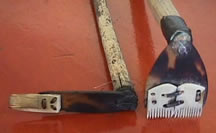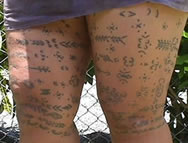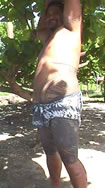Samoan Tattooing Instruments
The Samoan tattooing instruments I acquired in Apia are almost identical to the same tools I've studied at the Suva Museum in Fiji, which lends credence to the legend of the women bringing the art across the ocean to Samoa. I say almost, because the Fijians preferred to use human bone for the construction of the teeth on the striker; the Samoans usually used boar tusk. The ancient Fijians did love their human flesh as is evidenced by the specialty forks and platters reserved for the human feast and the human bones stuck in the forks of trees after dinner.

The Samoan
Tattoo
The Samoan tattoo is called a pea’a on the men and a malu on the women. The pea’as encompassed the entire area from above the waist to below the knee, and were usually done in one go, taking perhaps a week or two. The teeth of the hoe-like striking instrument were carved longitudinally from the incisors of the wild boar, which in turn was affixed to a piece of turtle shell. The teeth were sharpened with a piece of coral, and if not kept sharp will cause a lot of tissue damage. I have witnessed a fair amount of scarring in Samoan tattoos but some of the areas they tattoo! Behind the knee! Inside the crack of the
butt cheeks! No wonder! Before the advent of antibiotics in the 1940’s there was an alarming rate of infection, some actually leading to the death of the tattooed, fortunately that is no longer a problem.
Scrapping the soot off and mixing it
with...
 Like much of South Seas tattooing, Samoans used Candle nut as the basis for their pigment, burning it under half a coconut shell, then scrapping the soot off and mixing it with sugar water. My friend
Lars Krutak from the Smithsonian Institute insists that it has healing properties. Personally, I think it simply made the darkest, densest soot. A tattooist friend in Apia showed me a bottle of bluing used in washing that they actually added sometimes. I would presume that it lent the pigment a bluish hue as opposed to a reddish hue that some ferric oxide and carbon based pigments will exhibit. The late Doc Webb from San Diego taught me a similar trick when tattooing very dark skinned clients, a touch of blue mixed in with the black really does make the outline bolder.
Like much of South Seas tattooing, Samoans used Candle nut as the basis for their pigment, burning it under half a coconut shell, then scrapping the soot off and mixing it with sugar water. My friend
Lars Krutak from the Smithsonian Institute insists that it has healing properties. Personally, I think it simply made the darkest, densest soot. A tattooist friend in Apia showed me a bottle of bluing used in washing that they actually added sometimes. I would presume that it lent the pigment a bluish hue as opposed to a reddish hue that some ferric oxide and carbon based pigments will exhibit. The late Doc Webb from San Diego taught me a similar trick when tattooing very dark skinned clients, a touch of blue mixed in with the black really does make the outline bolder.
Tattooing on these islands is one of the only uninterrupted instances of this art form to still continue unabated. I truly hope it manages to transcend the present onslaught of western commercialization.




 Like much of South Seas tattooing, Samoans used Candle nut as the basis for their pigment, burning it under half a coconut shell, then scrapping the soot off and mixing it with sugar water. My friend
Like much of South Seas tattooing, Samoans used Candle nut as the basis for their pigment, burning it under half a coconut shell, then scrapping the soot off and mixing it with sugar water. My friend